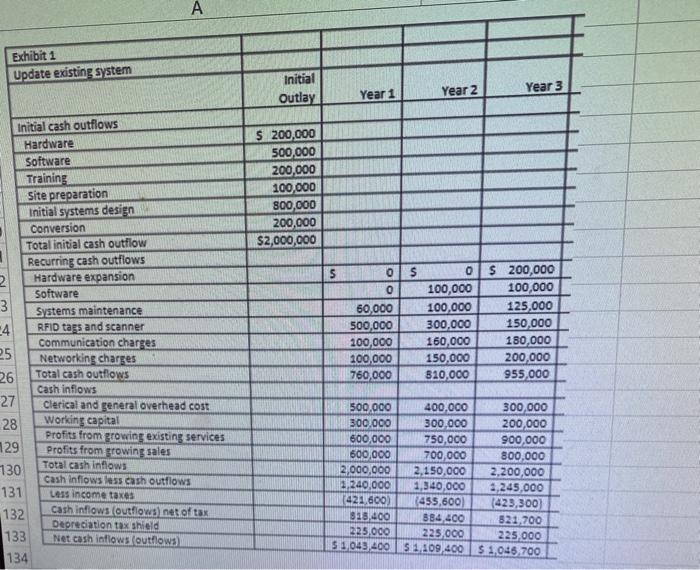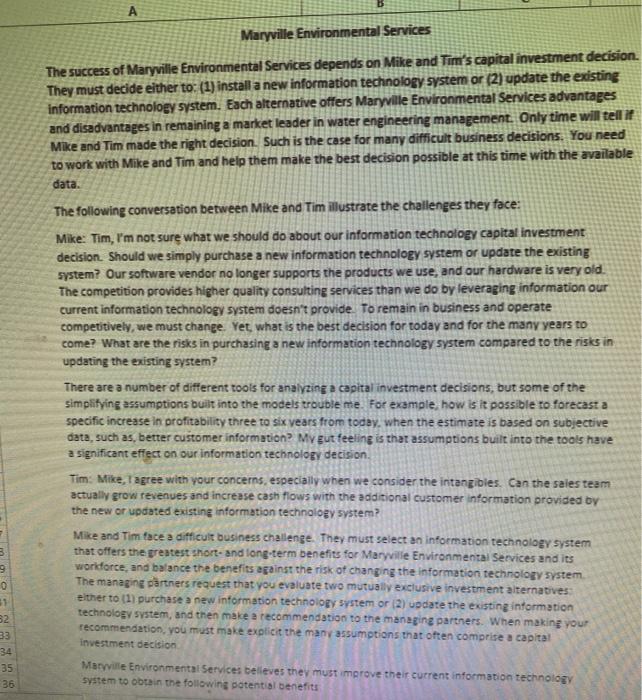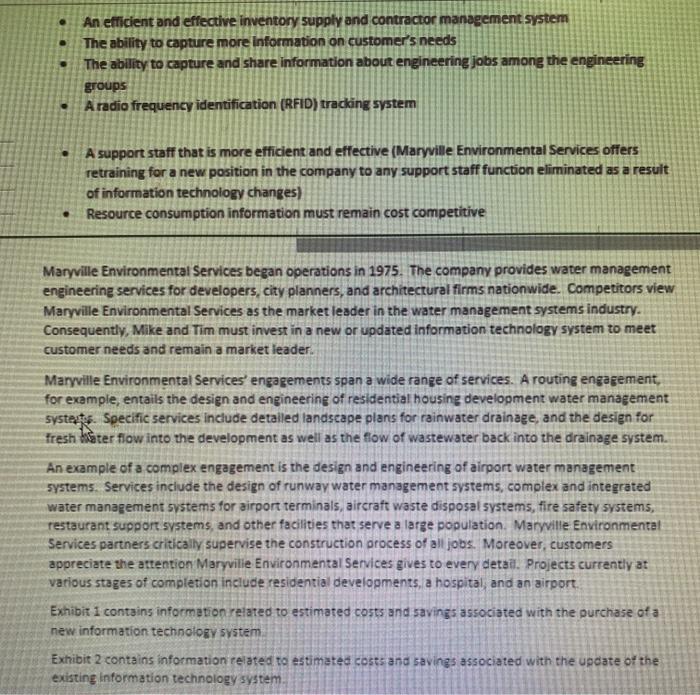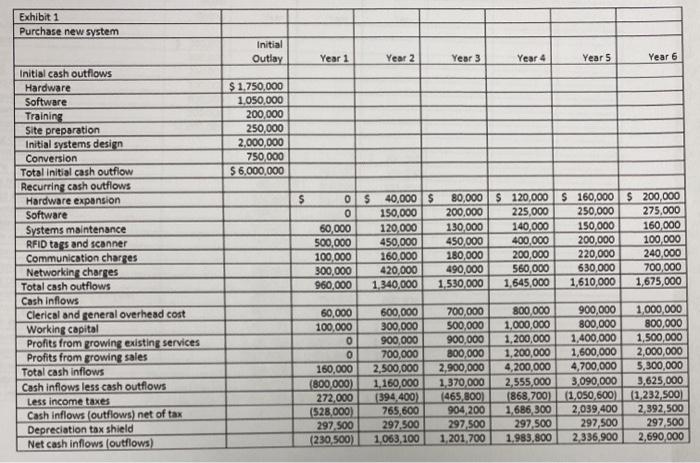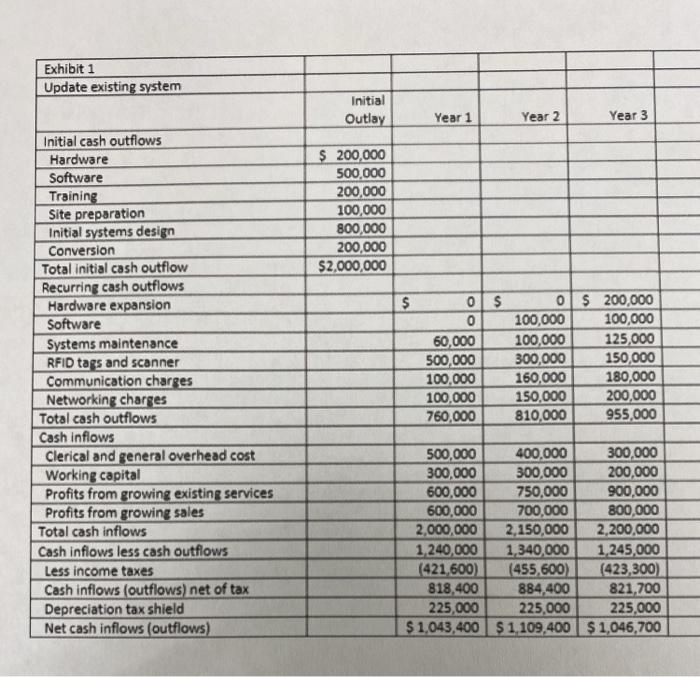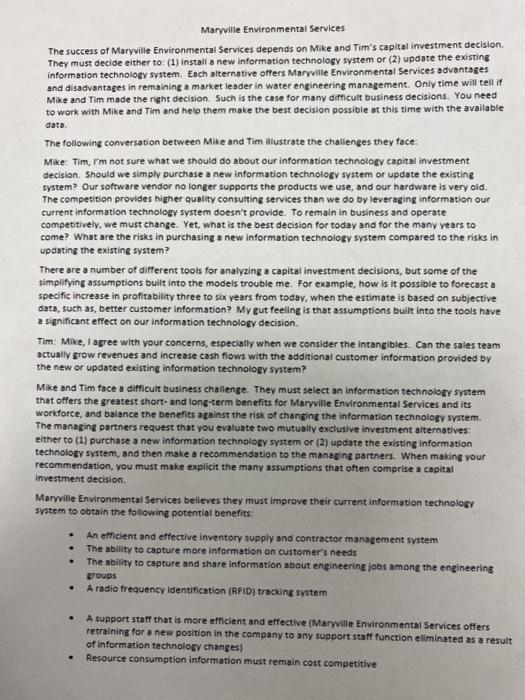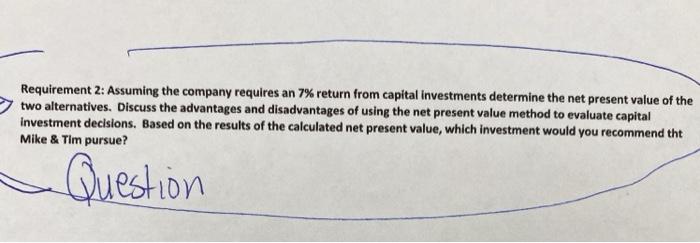B C D Exhibit 1 Purchase new system Initial Outlay Year 1 Year 2 Year 3 Year 4 Years Year 51.750,000 1,050,000 200,000 250.000 2.000.000 750,000 56,000,000 5 Initial cash outflows Hardware Software Training Site preparation Initial systems design Conversion Total initial cash outflow Recurring cash outflows Hardware expansion Software Systems maintenance RFID tags and scanner Communication charres Networking charges Total cash outflows Cash inflows Clerical and general overhead cost Worlong capital Profits from growing existing services Profits from growing sales Total cash inflows Cash inflows less cash outflows Less income taxes Cash inflows foutflows net of tax Depreciation tax shield Net cash inflows outflows Os 140.000 $ 30,000120,000 $ 160,000 200,000 0 150,000 200,000 225.000 250,000 275,000 50.000 120,000 130.000 140.000 150,000 100.000 500.000 450.000 450.000 200.000 200.000 100.000 100,000 160.000 180.000 200.000 220,000 240,000 300 000 420.000 490,000 560,000 630,000 700.000 960 000 1,340,000 2,330,000 3.645,000 1,610,000 1,675,000 60,000 100.000 160,000 B00.000) 272,000 1528.000 297,500 1230 500 600.000 300.000 200.000 700.000 2.500.000 1.160.000 394 400 765,500 297,500 063 100 700.000 500.000 p00.000 300,000 2.900,000 1,370.000 (265.800) 904 100 297.300 1.700 300,000 1.000.000 1.200 000 1,200.000 4 200 000 2.555,000 369.700) 1836.300 212500 3.983,800 900.000 300,000 1.400.000 1.600.000 4 700.000 3,000,000 (1,050.600 2.099 400 297,500 2335 900 1,000,000 800,000 1,500,000 2,000,000 3,300,000 3.625.000 11.237.500 2.392.500 297 500 2,000,000 A Exhibit 1 Update existing system Initial Outlay Year 3 Year 1 Year 2 $ 200,000 500,000 200,000 100,000 800,000 200,000 $2,000,000 5 Initial cash outflows Hardware Software Training Site preparation Initial systems design Conversion Total initial cash outflow Recurring cash outflows 2 Hardware expansion Software 3 Systems maintenance -4 RFID tags and scanner Communication charges 25 Networking charges 26 Total cash outflows Cash inflows 27 Clerical and general overhead cost 28 Working capital Profits from growing ex services 129 Profits from growing sales 130 Total cash inflows Cash inflows less cash outflows 131 Less income taxes 132 Cath inflows outflows net of tax Depreciation tax shield 133 Net cash inflows outflows 134 05 O S 200,000 0 100,000 100,000 60,000 100,000 125,000 500,000 300,000 150,000 100,000 160,000 180,000 100,000 150,000 200,000 760,000 310,000 955,000 500.000 400.000 300.000 300,000 600,000 750,000 600,000 700,000 2,000,000 2,150,000 1.240,000 1,340,000 (421.600) (455,600] 310,400 384,400 325,000 225.000 510434005 1.409,400 300,000 200,000 900,000 800,000 2,200,000 2,245,000 (423,300) 821,700 225.000 $ 1,045,700 Maryville Environmental Services The success of Maryville Environmental Services depends on Mike and Tim's capital investment decision. They must decide either to: (1) install a new information technology system or (2) update the existing information technology system. Each alternative offers Maryville Environmental Services advantages and disadvantages in remaining a market leader in water engineering management. Only time will tell if Mike and Tim made the right decision. Such is the case for many difficult business decisions. You need to work with Mike and Tim and help them make the best decision possible at this time with the available data. The following conversation between Mike and Tim illustrate the challenges they face: Mike: Tim, I'm not sure what we should do about our information technology capital investment decision. Should we simply purchase a new information technology system or update the existing system? Our software vendor no longer supports the products we use, and our hardware is very old The competition provides higher quality consulting services than we do by leveraging information our current information technology system doesn't provide. To remain in business and operate competitively, we must change. Yet, what is the best decision for today and for the many years to come? What are the risks in purchasing a new information technology system compared to the risks in updating the existing system? There are a number of different tools for analyzing a capital investment decisions, but some of the simplifying assumptions built into the models trouble me. For example, how is it possible to forecast a specific increase in profitability three to six years from today, when the estimate is based on subjective data, such as, better customer information? My gut feeling is that assumptions built into the tools have a significant effect on our information technology decision Tim: Mike, I agree with your concerns, especially when we consider the intangibles. Can the sales team actually grow revenues and increase cash flows with the additional customer information provided by the new or updated existing information technology system? 9 0 31 32 33 34 35 36 Mike and Tim tace a difficult business challenge. They must select an information technology system that offers the greatest short and long-term benefits for Maryville Environmental Services and its worldorce, and balance the benefits against the risk of changing the information technology system The managing partners request that you evaluate two mutually exclusive investment alternatives eitherto (1) purchase a new information technology system or (2) update the existing information technology system, and then make a recommendation to the managing partners. When making your recommendation, you must make explicit the many assumptions that often comprise a capital investment decision Maryville Environmental Services belleves they must improve their current information technology system to obtain the following potential benefits . An efficient and effective inventory supply and contractor management system The ability to capture more information on customer's needs The ability to capture and share information about engineering jobs among the engineering groups A radio frequency identification (RFID) tracking system A support staff that is more efficient and effective (Maryville Environmental Services offers retraining for a new position in the company to any support staff function eliminated as a result of information technology changes) Resource consumption information must remain cost competitive . Maryville Environmental Services began operations in 1975. The company provides water management engineering services for developers, city planners, and architectural firms nationwide. Competitors view Maryville Environmental Services as the market leader in the water management systems industry. Consequently, Mike and Tim must invest in a new or updated information technology system to meet customer needs and remain a market leader. Maryville Environmental Services' engagements span a wide range of services. A routing engagement, for example, entails the design and engineering of residential housing development water management systexts. Specific services include detailed landscape plans for rainwater drainage, and the design for fresh Water flow into the development as well as the flow of wastewater back into the drainage system An example of a complex engagement is the design and engineering of airport water management systems. Services include the design of runway water management systems, complex and integrated water management systems for airport terminals, aircraft waste disposal systems, fire safety systems, restaurant support systems, and other facilities that serve a large population. Maryville Environmental Services partners critically supervise the construction process of all jobs. Moreover, customers appreciate the attention Maryville Environmental Services gives to every detail. Projects currently at various stages of completion include residential developments, a hospital, and an airport Exhibit i contains information related to estimated costs and savings associated with the purchase of a new information technology system Exhibit 2 contains information related to estimated costs and savings associated with the update of the existing information technology system 2. Assuming the company requires an 7% return from capital investments determine the net present value of the two alternatives. Discuss the advantages and disadvantages of using the net present value method to evaluate capital investment decisions. Based on the results of the calculated net present value, which investment would you recommend that Mike and Tim pursue? Exhibit 1 Purchase new system Initial Outlay Year 1 Year 2 Year 3 Year 4 Year 5 Year 6 $1,750,000 1,050,000 200,000 250,000 2,000,000 750,000 $ 6,000,000 $ Olo Initial cash outflows Hardware Software Training Site preparation Initial systems design Conversion Total initial cash outflow Recurring cash outflows Hardware expansion Software Systems maintenance RFID tags and scanner Communication charges Networking charges Total cash outflows Cash inflows Clerical and reneral overhead cost Working Capital Profits from growing existing services Profits from growing sales Total cash inflows Cash inflows less cash outflows Less income taxes Cash inflows (outflows) net of tax Depreciation tax shield Net cash inflows (outflows) 60,000 500,000 100,000 300,000 960,000 $ 40,000 $ 80,000 $ 120,000 $ 160,000 $ 200,000 150,000 200,000 225,000 250,000 275,000 120,000 130,000 140,000 150,000 160,000 450,000 450,000 400,000 200,000 100,000 160,000 180,000 200,000 220,000 240,000 420,000 490,000 560,000 630,000 700,000 1.340,000 1.530,000 1.645,000 1,610,000 1,675,000 60,000 100,000 0 0 160,000 (800,000) 272,000 (528,000) 297,500 (230.500) 600,000 300,000 900,000 700,000 2,500,000 1.160,000 (394 400) 765,600 297,500 1,063, 100 700,000 500,000 900,000 800,000 2,900,000 1370.000 (465,800) 904 200 297,500 1,201,700 800,000 1,000,000 1,200,000 1,200,000 4,200,000 2.555.000 (868,700) 1.686 300 297,500 1.983,800 900,000 1,000,000 800,000 800,000 1,400,000 1,500,000 1,600,000 2,000,000 4.700,000 5,300,000 3,090,000 3,625,000 (1,050,600) (1,232,500) 2,039,400 2.392,500 297,500 297,500 2,336,900 2,690,000 Exhibit 1 Update existing system Initial Outlay Year 1 Year 2 Year 3 $ 200,000 500.000 200,000 100,000 800,000 200,000 $2,000,000 $ Initial cash outflows Hardware Software Training Site preparation Initial systems design Conversion Total initial cash outflow Recurring cash outflows Hardware expansion Software Systems maintenance RFID tags and scanner Communication charges Networking charges Total cash outflows Cash inflows Clerical and general overhead cost Working capital Profits from growing existing services Profits from growing sales Total cash inflows Cash inflows less cash outflows Less income taxes Cash inflows (outflows) net of tax Depreciation tax shield Net cash inflows (outflows) 0$ 0 $ 200,000 0 100,000 100,000 60,000 100,000 125,000 500,000 300,000 150,000 100,000 160,000 180,000 100,000 150.000 200,000 760,000 810,000 955,000 500,000 400.000 300,000 300,000 300,000 200,000 600,000 750,000 900,000 600,000 700,000 800,000 2,000,000 2,150,000 2,200,000 1.240,000 1,340,000 1,245,000 (421,600) (455,600) (423,300) 818,400 884,400 821,700 225,000 225,000 225,000 $ 1,043,400 $ 1,109,400 $ 1,046,700 Maryville Environmental Services The success of Maryville Environmental Services depends on Mike and Tim's capital investment decision They must decide either to: (1) install a new information technology system or (2) update the existing information technology system. Each alternative offers Maryville Environmental Services advantages and disadvantages in remaining a market leader in water engineering management. Only time will tell if Mike and Tim made the right decision. Such is the case for many difficult business decisions. You need to work with Mike and Tim and help them make the best decision possible at this time with the available The following conversation between Mike and Tim Hlustrate the challenges they face: Mike: Tim, I'm not sure what we should do about our information technology capital investment decision. Should we simply purchase a new information technology system or update the existing system? Our software vendor no longer supports the products we use, and our hardware is very old The competition provides higher quality consulting services than we do by leveraging information our current information technology system doesn't provide. To remain in business and operate competitively, we must change. Yet, what is the best decision for today and for the many years to come? What are the risks in purchasing a new information technology system compared to the risks in updating the existing system? There are a number of different tools for analyzing a capital investment decisions, but some of the simplifying assumptions built into the models trouble me. For example, how is it possible to forecast a specific increase in profitability three to six years from today, when the estimate is based on subjective data, such as, better customer information? My gut feeling is that assumptions built into the tools have a significant effect on our information technology decision Tim: Mike, I agree with your concerns, especially when we consider the intangibles. Can the sales team actually grow revenues and increase cash flows with the additional customer information provided by the new or updated existing information technology System? Mike and Tim face a difficult business challenge. They must select an information technology system that offers the greatest short and long-term benefits for Maryville Environmental Services and its workforce, and balance the benefits against the risk of changing the information technology system. The managing partners request that you evaluate two mutually exclusive investment alternatives: either to (1) purchase a new information technology system or (2) update the existing information technology system, and then make a recommendation to the managing partners. When making your recommendation, you must make explicit the many assumptions that often comprise a capital Investment decision Maryville Environmental Services believes they must improve their current information technology system to obtain the following potential benefits: . . An efficient and effective inventory supply and contractor management system The ability to capture more information on customer's needs The ability to capture and share information about engineering jobs among the engineering groups A radio frequency identification (RFID) tracking system A support staff that is more efficient and effective (Maryville Environmental Services offers retraining for a new position in the company to any support staff function eliminated as a result of Information technology changes) Resource consumption Information must remain cost competitive . Requirement 2: Assuming the company requires an 7% return from capital investments determine the net present value of the two alternatives. Discuss the advantages and disadvantages of using the net present value method to evaluate capital investment decisions. Based on the results of the calculated net present value, which investment would you recommend tht Mike & Tim pursue? Question B C D Exhibit 1 Purchase new system Initial Outlay Year 1 Year 2 Year 3 Year 4 Years Year 51.750,000 1,050,000 200,000 250.000 2.000.000 750,000 56,000,000 5 Initial cash outflows Hardware Software Training Site preparation Initial systems design Conversion Total initial cash outflow Recurring cash outflows Hardware expansion Software Systems maintenance RFID tags and scanner Communication charres Networking charges Total cash outflows Cash inflows Clerical and general overhead cost Worlong capital Profits from growing existing services Profits from growing sales Total cash inflows Cash inflows less cash outflows Less income taxes Cash inflows foutflows net of tax Depreciation tax shield Net cash inflows outflows Os 140.000 $ 30,000120,000 $ 160,000 200,000 0 150,000 200,000 225.000 250,000 275,000 50.000 120,000 130.000 140.000 150,000 100.000 500.000 450.000 450.000 200.000 200.000 100.000 100,000 160.000 180.000 200.000 220,000 240,000 300 000 420.000 490,000 560,000 630,000 700.000 960 000 1,340,000 2,330,000 3.645,000 1,610,000 1,675,000 60,000 100.000 160,000 B00.000) 272,000 1528.000 297,500 1230 500 600.000 300.000 200.000 700.000 2.500.000 1.160.000 394 400 765,500 297,500 063 100 700.000 500.000 p00.000 300,000 2.900,000 1,370.000 (265.800) 904 100 297.300 1.700 300,000 1.000.000 1.200 000 1,200.000 4 200 000 2.555,000 369.700) 1836.300 212500 3.983,800 900.000 300,000 1.400.000 1.600.000 4 700.000 3,000,000 (1,050.600 2.099 400 297,500 2335 900 1,000,000 800,000 1,500,000 2,000,000 3,300,000 3.625.000 11.237.500 2.392.500 297 500 2,000,000 A Exhibit 1 Update existing system Initial Outlay Year 3 Year 1 Year 2 $ 200,000 500,000 200,000 100,000 800,000 200,000 $2,000,000 5 Initial cash outflows Hardware Software Training Site preparation Initial systems design Conversion Total initial cash outflow Recurring cash outflows 2 Hardware expansion Software 3 Systems maintenance -4 RFID tags and scanner Communication charges 25 Networking charges 26 Total cash outflows Cash inflows 27 Clerical and general overhead cost 28 Working capital Profits from growing ex services 129 Profits from growing sales 130 Total cash inflows Cash inflows less cash outflows 131 Less income taxes 132 Cath inflows outflows net of tax Depreciation tax shield 133 Net cash inflows outflows 134 05 O S 200,000 0 100,000 100,000 60,000 100,000 125,000 500,000 300,000 150,000 100,000 160,000 180,000 100,000 150,000 200,000 760,000 310,000 955,000 500.000 400.000 300.000 300,000 600,000 750,000 600,000 700,000 2,000,000 2,150,000 1.240,000 1,340,000 (421.600) (455,600] 310,400 384,400 325,000 225.000 510434005 1.409,400 300,000 200,000 900,000 800,000 2,200,000 2,245,000 (423,300) 821,700 225.000 $ 1,045,700 Maryville Environmental Services The success of Maryville Environmental Services depends on Mike and Tim's capital investment decision. They must decide either to: (1) install a new information technology system or (2) update the existing information technology system. Each alternative offers Maryville Environmental Services advantages and disadvantages in remaining a market leader in water engineering management. Only time will tell if Mike and Tim made the right decision. Such is the case for many difficult business decisions. You need to work with Mike and Tim and help them make the best decision possible at this time with the available data. The following conversation between Mike and Tim illustrate the challenges they face: Mike: Tim, I'm not sure what we should do about our information technology capital investment decision. Should we simply purchase a new information technology system or update the existing system? Our software vendor no longer supports the products we use, and our hardware is very old The competition provides higher quality consulting services than we do by leveraging information our current information technology system doesn't provide. To remain in business and operate competitively, we must change. Yet, what is the best decision for today and for the many years to come? What are the risks in purchasing a new information technology system compared to the risks in updating the existing system? There are a number of different tools for analyzing a capital investment decisions, but some of the simplifying assumptions built into the models trouble me. For example, how is it possible to forecast a specific increase in profitability three to six years from today, when the estimate is based on subjective data, such as, better customer information? My gut feeling is that assumptions built into the tools have a significant effect on our information technology decision Tim: Mike, I agree with your concerns, especially when we consider the intangibles. Can the sales team actually grow revenues and increase cash flows with the additional customer information provided by the new or updated existing information technology system? 9 0 31 32 33 34 35 36 Mike and Tim tace a difficult business challenge. They must select an information technology system that offers the greatest short and long-term benefits for Maryville Environmental Services and its worldorce, and balance the benefits against the risk of changing the information technology system The managing partners request that you evaluate two mutually exclusive investment alternatives eitherto (1) purchase a new information technology system or (2) update the existing information technology system, and then make a recommendation to the managing partners. When making your recommendation, you must make explicit the many assumptions that often comprise a capital investment decision Maryville Environmental Services belleves they must improve their current information technology system to obtain the following potential benefits . An efficient and effective inventory supply and contractor management system The ability to capture more information on customer's needs The ability to capture and share information about engineering jobs among the engineering groups A radio frequency identification (RFID) tracking system A support staff that is more efficient and effective (Maryville Environmental Services offers retraining for a new position in the company to any support staff function eliminated as a result of information technology changes) Resource consumption information must remain cost competitive . Maryville Environmental Services began operations in 1975. The company provides water management engineering services for developers, city planners, and architectural firms nationwide. Competitors view Maryville Environmental Services as the market leader in the water management systems industry. Consequently, Mike and Tim must invest in a new or updated information technology system to meet customer needs and remain a market leader. Maryville Environmental Services' engagements span a wide range of services. A routing engagement, for example, entails the design and engineering of residential housing development water management systexts. Specific services include detailed landscape plans for rainwater drainage, and the design for fresh Water flow into the development as well as the flow of wastewater back into the drainage system An example of a complex engagement is the design and engineering of airport water management systems. Services include the design of runway water management systems, complex and integrated water management systems for airport terminals, aircraft waste disposal systems, fire safety systems, restaurant support systems, and other facilities that serve a large population. Maryville Environmental Services partners critically supervise the construction process of all jobs. Moreover, customers appreciate the attention Maryville Environmental Services gives to every detail. Projects currently at various stages of completion include residential developments, a hospital, and an airport Exhibit i contains information related to estimated costs and savings associated with the purchase of a new information technology system Exhibit 2 contains information related to estimated costs and savings associated with the update of the existing information technology system 2. Assuming the company requires an 7% return from capital investments determine the net present value of the two alternatives. Discuss the advantages and disadvantages of using the net present value method to evaluate capital investment decisions. Based on the results of the calculated net present value, which investment would you recommend that Mike and Tim pursue? Exhibit 1 Purchase new system Initial Outlay Year 1 Year 2 Year 3 Year 4 Year 5 Year 6 $1,750,000 1,050,000 200,000 250,000 2,000,000 750,000 $ 6,000,000 $ Olo Initial cash outflows Hardware Software Training Site preparation Initial systems design Conversion Total initial cash outflow Recurring cash outflows Hardware expansion Software Systems maintenance RFID tags and scanner Communication charges Networking charges Total cash outflows Cash inflows Clerical and reneral overhead cost Working Capital Profits from growing existing services Profits from growing sales Total cash inflows Cash inflows less cash outflows Less income taxes Cash inflows (outflows) net of tax Depreciation tax shield Net cash inflows (outflows) 60,000 500,000 100,000 300,000 960,000 $ 40,000 $ 80,000 $ 120,000 $ 160,000 $ 200,000 150,000 200,000 225,000 250,000 275,000 120,000 130,000 140,000 150,000 160,000 450,000 450,000 400,000 200,000 100,000 160,000 180,000 200,000 220,000 240,000 420,000 490,000 560,000 630,000 700,000 1.340,000 1.530,000 1.645,000 1,610,000 1,675,000 60,000 100,000 0 0 160,000 (800,000) 272,000 (528,000) 297,500 (230.500) 600,000 300,000 900,000 700,000 2,500,000 1.160,000 (394 400) 765,600 297,500 1,063, 100 700,000 500,000 900,000 800,000 2,900,000 1370.000 (465,800) 904 200 297,500 1,201,700 800,000 1,000,000 1,200,000 1,200,000 4,200,000 2.555.000 (868,700) 1.686 300 297,500 1.983,800 900,000 1,000,000 800,000 800,000 1,400,000 1,500,000 1,600,000 2,000,000 4.700,000 5,300,000 3,090,000 3,625,000 (1,050,600) (1,232,500) 2,039,400 2.392,500 297,500 297,500 2,336,900 2,690,000 Exhibit 1 Update existing system Initial Outlay Year 1 Year 2 Year 3 $ 200,000 500.000 200,000 100,000 800,000 200,000 $2,000,000 $ Initial cash outflows Hardware Software Training Site preparation Initial systems design Conversion Total initial cash outflow Recurring cash outflows Hardware expansion Software Systems maintenance RFID tags and scanner Communication charges Networking charges Total cash outflows Cash inflows Clerical and general overhead cost Working capital Profits from growing existing services Profits from growing sales Total cash inflows Cash inflows less cash outflows Less income taxes Cash inflows (outflows) net of tax Depreciation tax shield Net cash inflows (outflows) 0$ 0 $ 200,000 0 100,000 100,000 60,000 100,000 125,000 500,000 300,000 150,000 100,000 160,000 180,000 100,000 150.000 200,000 760,000 810,000 955,000 500,000 400.000 300,000 300,000 300,000 200,000 600,000 750,000 900,000 600,000 700,000 800,000 2,000,000 2,150,000 2,200,000 1.240,000 1,340,000 1,245,000 (421,600) (455,600) (423,300) 818,400 884,400 821,700 225,000 225,000 225,000 $ 1,043,400 $ 1,109,400 $ 1,046,700 Maryville Environmental Services The success of Maryville Environmental Services depends on Mike and Tim's capital investment decision They must decide either to: (1) install a new information technology system or (2) update the existing information technology system. Each alternative offers Maryville Environmental Services advantages and disadvantages in remaining a market leader in water engineering management. Only time will tell if Mike and Tim made the right decision. Such is the case for many difficult business decisions. You need to work with Mike and Tim and help them make the best decision possible at this time with the available The following conversation between Mike and Tim Hlustrate the challenges they face: Mike: Tim, I'm not sure what we should do about our information technology capital investment decision. Should we simply purchase a new information technology system or update the existing system? Our software vendor no longer supports the products we use, and our hardware is very old The competition provides higher quality consulting services than we do by leveraging information our current information technology system doesn't provide. To remain in business and operate competitively, we must change. Yet, what is the best decision for today and for the many years to come? What are the risks in purchasing a new information technology system compared to the risks in updating the existing system? There are a number of different tools for analyzing a capital investment decisions, but some of the simplifying assumptions built into the models trouble me. For example, how is it possible to forecast a specific increase in profitability three to six years from today, when the estimate is based on subjective data, such as, better customer information? My gut feeling is that assumptions built into the tools have a significant effect on our information technology decision Tim: Mike, I agree with your concerns, especially when we consider the intangibles. Can the sales team actually grow revenues and increase cash flows with the additional customer information provided by the new or updated existing information technology System? Mike and Tim face a difficult business challenge. They must select an information technology system that offers the greatest short and long-term benefits for Maryville Environmental Services and its workforce, and balance the benefits against the risk of changing the information technology system. The managing partners request that you evaluate two mutually exclusive investment alternatives: either to (1) purchase a new information technology system or (2) update the existing information technology system, and then make a recommendation to the managing partners. When making your recommendation, you must make explicit the many assumptions that often comprise a capital Investment decision Maryville Environmental Services believes they must improve their current information technology system to obtain the following potential benefits: . . An efficient and effective inventory supply and contractor management system The ability to capture more information on customer's needs The ability to capture and share information about engineering jobs among the engineering groups A radio frequency identification (RFID) tracking system A support staff that is more efficient and effective (Maryville Environmental Services offers retraining for a new position in the company to any support staff function eliminated as a result of Information technology changes) Resource consumption Information must remain cost competitive . Requirement 2: Assuming the company requires an 7% return from capital investments determine the net present value of the two alternatives. Discuss the advantages and disadvantages of using the net present value method to evaluate capital investment decisions. Based on the results of the calculated net present value, which investment would you recommend tht Mike & Tim pursue

